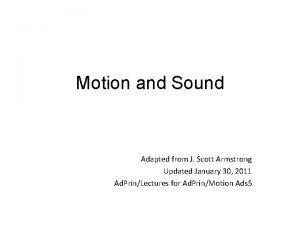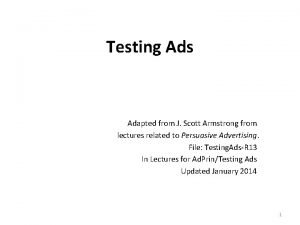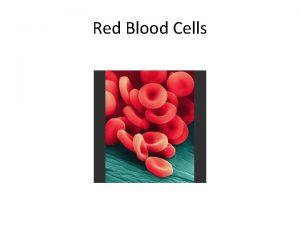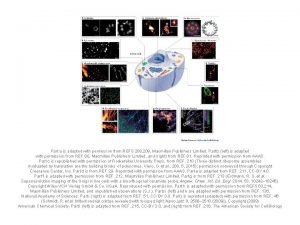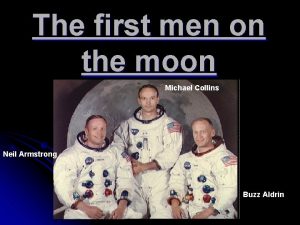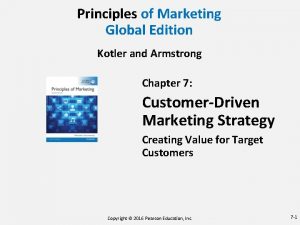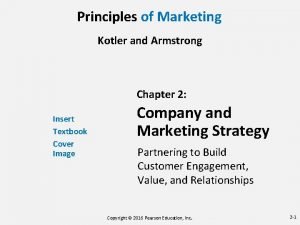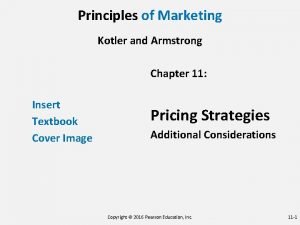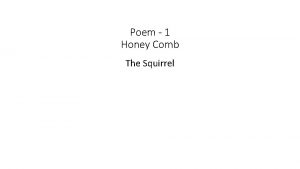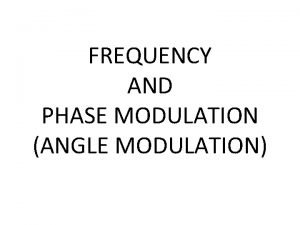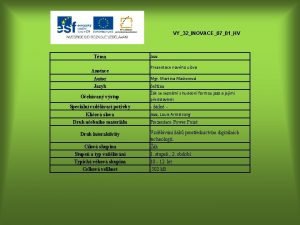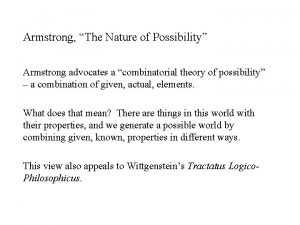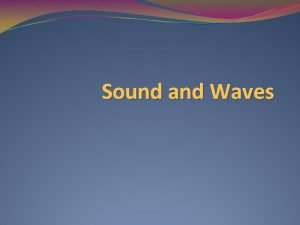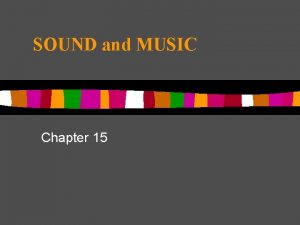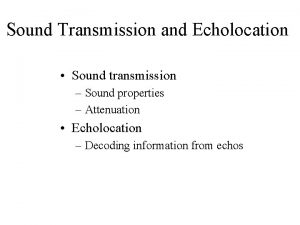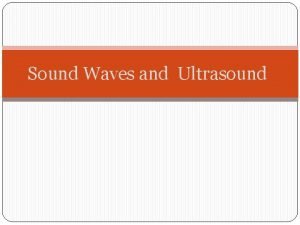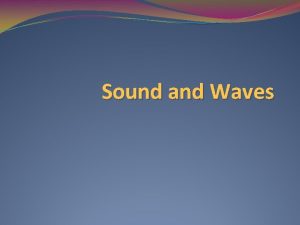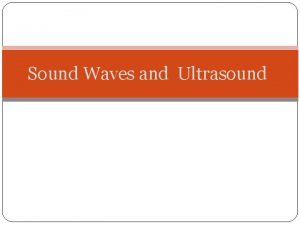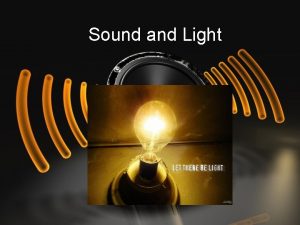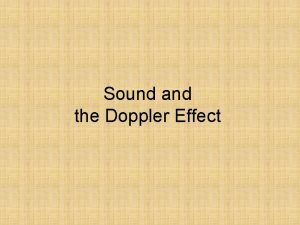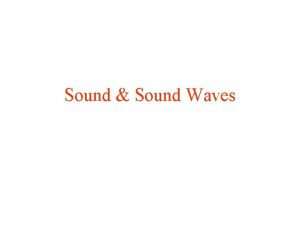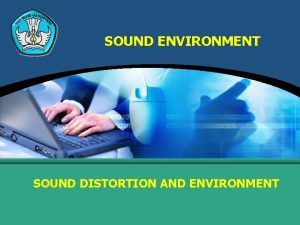Motion and Sound Adapted from J Scott Armstrong

































- Slides: 33

Motion and Sound Adapted from J. Scott Armstrong Updated January 30, 2011 Ad. Prin/Lectures for Ad. Prin/Motion Ads 5

Outline for Motion and Sound 10. 1. Scenes 10. 2. Voices 10. 3. Music and sound 10. 4. Pace 2

Motion and sound more appropriate for: 1. Emotional appeals (than for information). 2. Reinforcing beliefs (than for change) 3. Simple (than for complex messages) - Commercials with much information also irritate viewers (Pasadeos 1990) 4. Demonstrations Use these questions to assess which media to use.

Is this commercial for Subaru effective relative to other media? 1. 2. 3. 4. Is emotion a good way to sell this car? Does it reinforce previous beliefs? Is the message simple? Does it demonstrate usage or benefits? 4

Opening scene Use an opening that is directly related to the product, brand, or message (10. 1. 1) Especially for high-involvement problemsolving products. Do not put it at the very beginning. Need one or two seconds to capture attention. Evidence: Typical practice and many analyses of non-experimental data. 5

Provide a relevant surprise in the opening Evidence based on typical practice. 77% of TV ads opened with a surprise 99. 5% of the surprises were at the beginning What type of surprise? Relevant to the product (preferably news) 6

Emphasize the product or message (10. 1. 2) • Zoom in on product so it is legible Close-ups increase attention & involvement • Hold product, brand name, or message (zap proofing) • Lighting of product (e. g. spot lighting) • Prominent placement (use the “inner thirds”) 7

Non-experimental evidence favors emphasis on the product Analysis of data on TV commercials: Stewart & Furse (1986) (1, 059 commercials) Stanton and Burke (1998) (601 commercials) Ipsos ASI (1, 488 thirty-second commercials): seconds on product none 1 -12 13 -19 19 & more persuasion % 66 90 105 106 8

What is the product and message? Here is a new car. So? This was part of the introduction of a new car, the Infiniti, to the US market. Why this approach? This mysterious emotional approach was popular in Japanese advertising at the time. No evidence to support such an approach.

What is the product and message? A bad thing happened. Gun control laws are needed to prevent this in the future. 1. 2. 3. 4. Is emotion a good way to sell this idea? Does it reinforce previous beliefs? Is the message simple? Does it demonstrate usage or benefits? This was a highly effective commercial that helped lead to a change in laws in Australia.

If believability is important, show the spokesperson on screen (10. 1. 3. ) Disadvantages: 1. Does not focus on the product 2. More difficult to adapt ad to other languages Evidence: Non-experimental evidence: Higher on recall than voice-overs (weak evidence) Expert judgment 11

Use short “supers” to reinforce key points (10. 1. 4. ) 1. No more than ten words on screen at any time 2. Should stay at least two seconds 3. Synchronize with audio 12

Do supers work in this commercial for Subaru? 1. No more than ten words on screen at any time? ? 2. Should stay at least two seconds? ? 3. Synchronize with audio? ? 13

Evidence on supers Experimental study with 22 TV commercials found comprehension was much higher when supers reinforced content (Hoyer, et al 1984). Non-experimental evidence shows little benefit for ads with supers except when they reinforced the main point. 92% of 1, 059 tested TV commercials contained “substantive supers. ” (Stewart and Furse 1986) 14

Make the closing scene relevant to the key message (10. 1. 5) Laboratory research in psychology Received wisdom

Avoid distractions in the closing scene Experts advise against the use of clever but irrelevant throwaway lines at the end of an ad. In a 2005 TV commercial for a smaller Hummer automobile, a small man walks into a group meeting. Everyone is stumped until he says, “Why not make it smaller? ” The ad then shows a smaller version of the Hummer. The final scene shows the small man walking past a tall, well-endowed woman in their office. That overwhelmed the message. 16

Use an appropriate voice (10. 2. 1. ) Match accent to target market (e. g. , teens) Match voice qualities to objectives of the ad (e. g. , believability) Match voice qualities to product (clothing; technical product) Limited evidence 17

Which of the following can you tell from hearing a person’s voice? Typical study: different people read the same script. ___ age? ___ height? ___ appearance? ___ interests? ___ political preferences? ___ personality? ___ values? ___ intelligence? All of the above, but only age can be judged well. However, people make inferences. 18

Voice qualities An experimental study on willingness to be interviewed showed success was higher for interviewers with: • higher pitch, • greater variation in pitch, • greater loudness, • faster rate of speaking, and • clearer pronunciation. 19

Avoid orally ambiguous words (10. 2. 2) Listen to the following announcement: “They raised the new house as soon as the old one was razed. ” Is it possible to avoid ambiguous words? French book La Disparition, by Georges Perec (1969), was written without the letter “e” and it was translated to English, also without the “e, ” and then reviewed in The New York Times without an “e. ” Also, consider reinforcing ambiguous words by repetition or by supers. 20

Music and sound Can be used to 1. gain attention, 2. establish mood or emotions, 3. evoke a time period, 4. identify a brand. Percentage of TV commercials (by major advertisers) that use music: 40%, although 85% in prime time 21

Consider using music or sounds for lowinvolvement products, but not for highinvolvement products with strong arguments (10. 3. 1. ) Music is appropriate for pleasure products that are advertised using emotion. Non-experimental studies and an experimental study show that music harms recall. Experimental study showed that music increased purchase intentions for a shampoo under lowinvolvement, but decreased them under highinvolvement. “If you have nothing to say, sing it. ” - Old adage 22

Assume that you go to a supermarket. While there, you walk past a wine display with German and French wine. German music is playing. Would this make you more likely to purchase German wine? If German music, twice as much German wine. If French music, five times as much French wine. When asked why, only 2% mentioned music and 86% said it had no influence on their choice. If music or effects are used, make them relevant to the product (10. 3. 2). 23

Use sound effects only if relevant to the product Examples: The fizz of a soda drink and the percolating sounds of coffee Danger of distraction Rarely used (2% of tested TV commercials) Weak but supportive evidence 24

When should announcers speak fast? Use a rapid speaking for simple messages about low-involvement products (10. 4. 1. ) The typical speaking rate is about 160 words per minute. Listeners prefer about 175 wpm. Fast talkers are judged as more competent, truthful, fluent, energetic, enthusiastic, and persuasive than slow speakers 25

How to speak fast Can use time compression equipment to increase speed by 30% with little effect on behavioral intentions, recall, believability or appeal, and only slight losses in comprehension -- except for older target markets. Big savings on media costs. 26

Use a slow speech for strong arguments or to show concern (10. 4. 2) “Gentlemen, listen to me slowly. ” Samuel Goldwyn A fast pace disrupts thinking about the arguments. It harms comprehension for older customers. 27

Use short silences before and/or after a strong arguments (10. 4. 3. ) Support by advertising experts. Use a silence of two seconds (avoid silences of 3 seconds on longer). Silence especially important before the last item in a series. (Olsen 1997) Silence just before an key argument led to 44% recall of the argument vs. 15% for music throughout. (Olsen 1995) 28

Scene changes In time, there has been a substantial increase in the number of scene changes. 30 -second commercials decreased from 3. 6 seconds in 1978 and 1980, to 2. 3 seconds in 1989 through 1991. The number of camera angles increased from 8. 4 to 13. Why is that? Advertisers seeking attention, especially from young customers? Is that a good trend? Fast pace attracts attention but reduces comprehension. 29

Hold scenes to hold attention (10. 4. 4) Evidence: Three small experimental studies One study of non-experimental data

When using scene changes, allow slight delay prior to key points 16% gain in recall for visual information and 6% gain for audio information (Lang 1992, experimental study). 31

Application session Apply the principles from this session to other commercials. 32

Checklist for Motion Ads ___ 10. 1. 1. Use an opening that is directly related to the product , brand or message. ___ 10. 1. 2. Emphasize the product or message. ___ 10. 1. 3. If believability is important, show the spokesperson on-screen. ___ 10. 1. 4. Use short “supers” to reinforce key points. ___ 10. 1. 5. Make the closing scene relevant to the key message ___ 10. 2. 1 Use an appropriate voice. ___ 10. 2. 2. Avoid orally ambiguous words. ___ 10. 3. 1. Consider using music or sounds for low-involvement products, but not for highinvolvement products with strong arguments. ___ 10. 3. 2. If music or sound effects are used, make them relevant to the product. ___ 10. 4. 1. Use rapid speech for simple messages about lowinvolvement products. ___ 10. 4. 2. Use slow speech for strong arguments or to show concern. ___ 10. 4. 3. Consider short silences before and/or after strong arguments. ___ 10. 4. 4. Hold scenes to hold attention. 33
 J scott armstrong
J scott armstrong J. scott armstrong
J. scott armstrong What is sound
What is sound This passage is adapted from jane austen
This passage is adapted from jane austen Red blood cells are
Red blood cells are Adapted with permission from
Adapted with permission from In what ways have the highland maya adapted to modern life?
In what ways have the highland maya adapted to modern life? How are plants adapted for gas exchange
How are plants adapted for gas exchange Birds in the chaparral biome have adapted to living
Birds in the chaparral biome have adapted to living Adaptation of camel in points
Adaptation of camel in points Sausage shaped organelles
Sausage shaped organelles Best brother quotes
Best brother quotes Adapted from the internet
Adapted from the internet How is amoeba adapted for gas exchange bbc bitesize
How is amoeba adapted for gas exchange bbc bitesize How have plants adapted to the rainforest
How have plants adapted to the rainforest Spermopsida
Spermopsida The outsiders adapted for struggling readers
The outsiders adapted for struggling readers Destination synoynm
Destination synoynm How are giraffes long necks adapted to their lifestyle
How are giraffes long necks adapted to their lifestyle Michael collins buzz aldrin and neil armstrong
Michael collins buzz aldrin and neil armstrong Customer driven marketing strategy
Customer driven marketing strategy Principles of marketing pearson slides
Principles of marketing pearson slides Kotler p. armstrong g. principles of marketing
Kotler p. armstrong g. principles of marketing “a sound mind is in a sound body”
“a sound mind is in a sound body” Range of motion active and passive
Range of motion active and passive Captive-product pricing
Captive-product pricing Mildred bowers armstrong image
Mildred bowers armstrong image Character traits of neil armstrong
Character traits of neil armstrong Keuntungan dari osilator hartley meliputi
Keuntungan dari osilator hartley meliputi Armstrong method of fm generation
Armstrong method of fm generation Trish armstrong child
Trish armstrong child Yuri armstrong
Yuri armstrong Timeline of neil armstrong
Timeline of neil armstrong Jazz prezentace
Jazz prezentace
